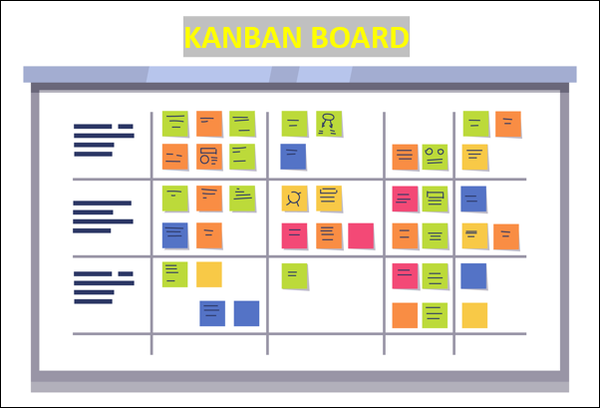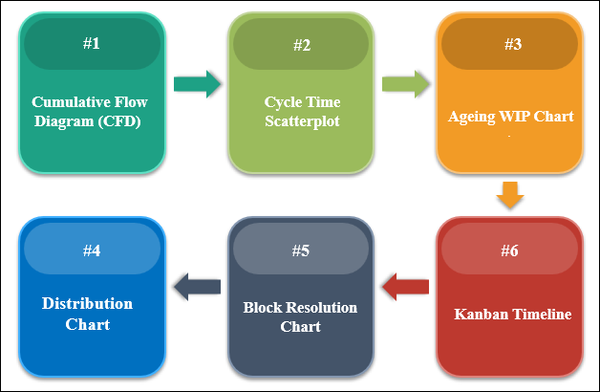A Comprehensive Guide To Kanban Charts
In recent times, project management has become one of the most influential methodologies to increase productivity in a workplace. As businesses take on more and more projects, they have become aware of the need for the right approach to handle all tasks and issues that come with it.
Project management is a broad domain with multiple methods that serve a specific purpose. However, the ultimate goal is successful project completion, and these methods have proven to be highly beneficial.

Kanban Charts: An Overview
Kanban is a Japanese word that translates to 'visual signal' and was first developed by Taiichi Ohno, an engineer who worked at Toyota in the 1940s. When handling particular tasks, especially the more complex ones, it is easy to lose sight of them if they aren't tangible.
Kanban is an extremely helpful tool as it brings all the ideas and objectives onto a board. With the help of charts, cards, diagrams and other tracking methods, you can view your progress and identify any possible hiccups or risks.
Elements of a Kanban Chart
1. Columns
A Kanban chart typically breaks down a project into three main components: Requested Tasks, In-progress Tasks, and Completed Tasks. Together they make the overall workflow of the project, and the separation of these three into columns gives clarity on the status of each task.
2. Visual Cards
These cards represent each task, specifying the work to be done and what is needed to get it done. These can be colour coordinated as per priority, team, and more. These cards will also mention the deadline of the project. Having all the tasks on the board will ensure that the team never misses out on anything.
3. Work in Progress (WIP) Limits
When you limit the number of tasks under the WIP column, you can make sure that the team can only focus on what's important before taking up any new tasks. It also allows them to concentrate more on the tasks at hand rather than getting distracted by pending, future tasks.
Kanban Charts and How To Track Progress In Kanban
Here are some tools that can help one track the progress of their project with Kanban.
1. Cumulative Flow Diagram (CFD)
CFD is a graphical chart that measures the progress of tasks over time. On the graph, the vertical line shows the number of tasks in absolute value, and the horizontal line is the timeline. The graph helps us keep a check on whether we are finishing up tasks on time or not.
2. Cycle Time Scatterplot
Here, there are two things to keep in mind: cycle time and lead time. Cycle time is the time taken to complete an ongoing task, and lead time is the time between when a request has been put up till the day of delivery. It helps keep track of the progress and gauge which tasks will soon exit the workflow.
3. Ageing WIP Chart
Unlike the cycle time scatterplot, the ageing WIP chart gives you an overall understanding of the progress of all the tasks in the project. You can check whether tasks are piling up or not. You can check the pace percentile of the task and find out how much time it takes for tasks advanced in a workflow.
4. Distribution Chart
These are pie charts that you can use to visualise tasks per a unit of measure of your choice, say, size or submission deadline. It is a daily easier tool to understand and gives you an overall idea of what tasks are present on the Kanban chart.
5. Block Resolution Chart
This chart shows how much time it takes to resolve a blocked task. Furthermore, if you hover over the column, you can see the reason behind the delay.
6. Kanban Timeline
Being more than a tool than a chart, the Kanban timeline helps understand how all the tasks, no matter how small or big, are progressing over a period of time. This allows constant reporting or tasks and keeps you alert at all times.

Track Progress with Kanban Charts: Benefits
There are numerous benefits to tracking your project's progress using Kanban boards.
1. It Increases Efficiency
With tangible visualisation, there is clear communication about the tasks and everything that needs to be done. There is no need to go back and forth with various team members or leaders for clarity on the task list. With the help of Kanban, every single member of the team will be on the same page.
2. It Brings Flexibility
Kanban allows team members to be flexible with their tasks. They can take up tasks they think need the most attention, and with a WIP limit, they are not pressured to tackle all tasks simultaneously. Working on well-defined tasks one at a time prevents the confusion and stress caused by undefined or loosely defined tasks.
3. Downtime is Reduced
With such a balanced form of work model, the team is able to effectively work on tasks and deliver on time. Kanban is proven to improve the quality of workflow, which makes project turnover time quicker. The Kanban model is especially useful to simplify elaborate, time-sensitive projects and make them appear less intimidating.
Wrapping It Up
The project management approach has a lot to offer, with concepts like Kanban taking centre stage as one of the most useful methods for improving project workflow. If you're a project manager, take the time to understand Kanban and educate your team about the same. Use it in a handful of company projects and assess how well it works for individuals and teams. You can fine-tune your approach based on their input, progress, and the final outcome of the project. Let Kanban become a strong asset for your enterprise and fulfil all your tasks in time, and watch all your projects become a total success.



